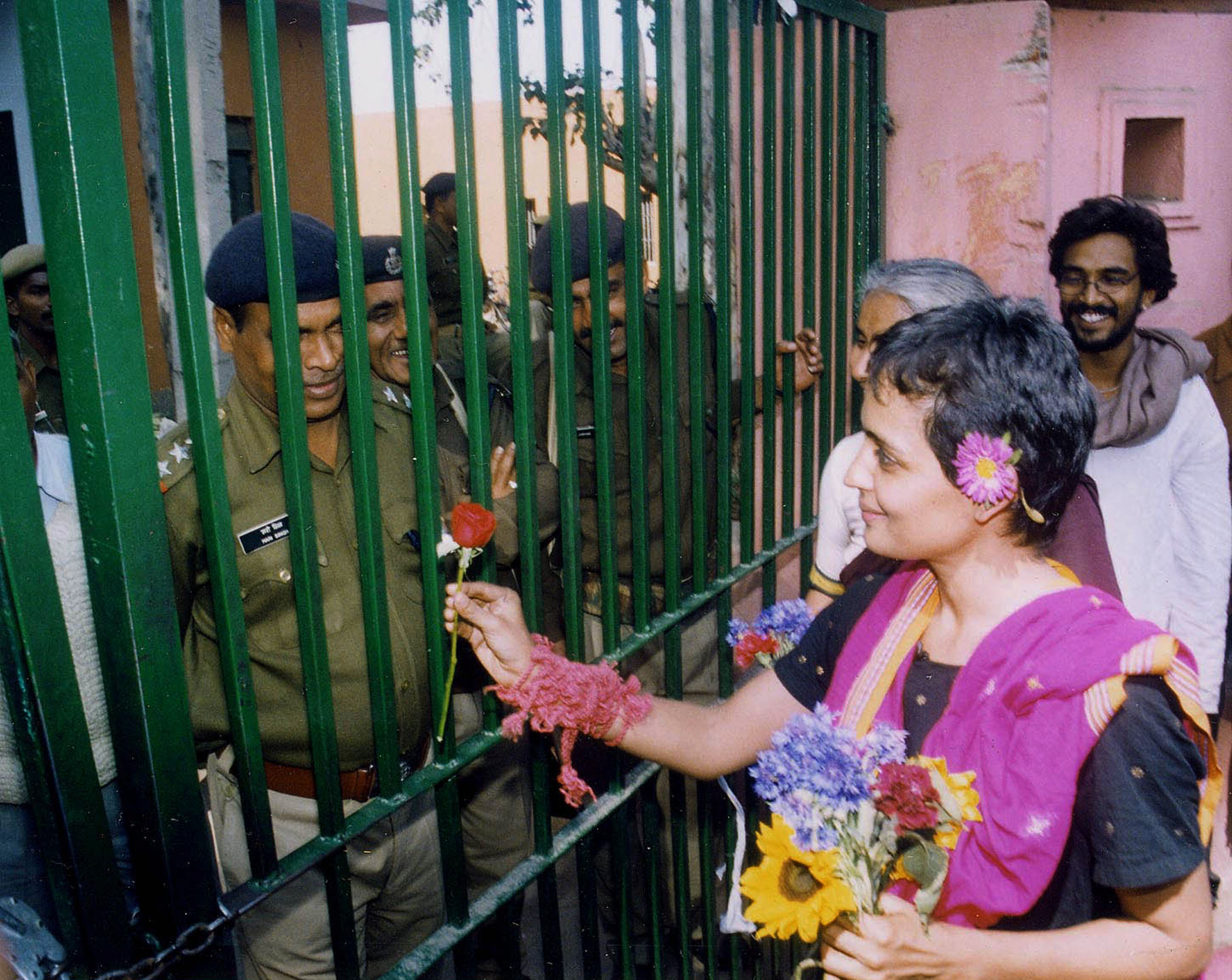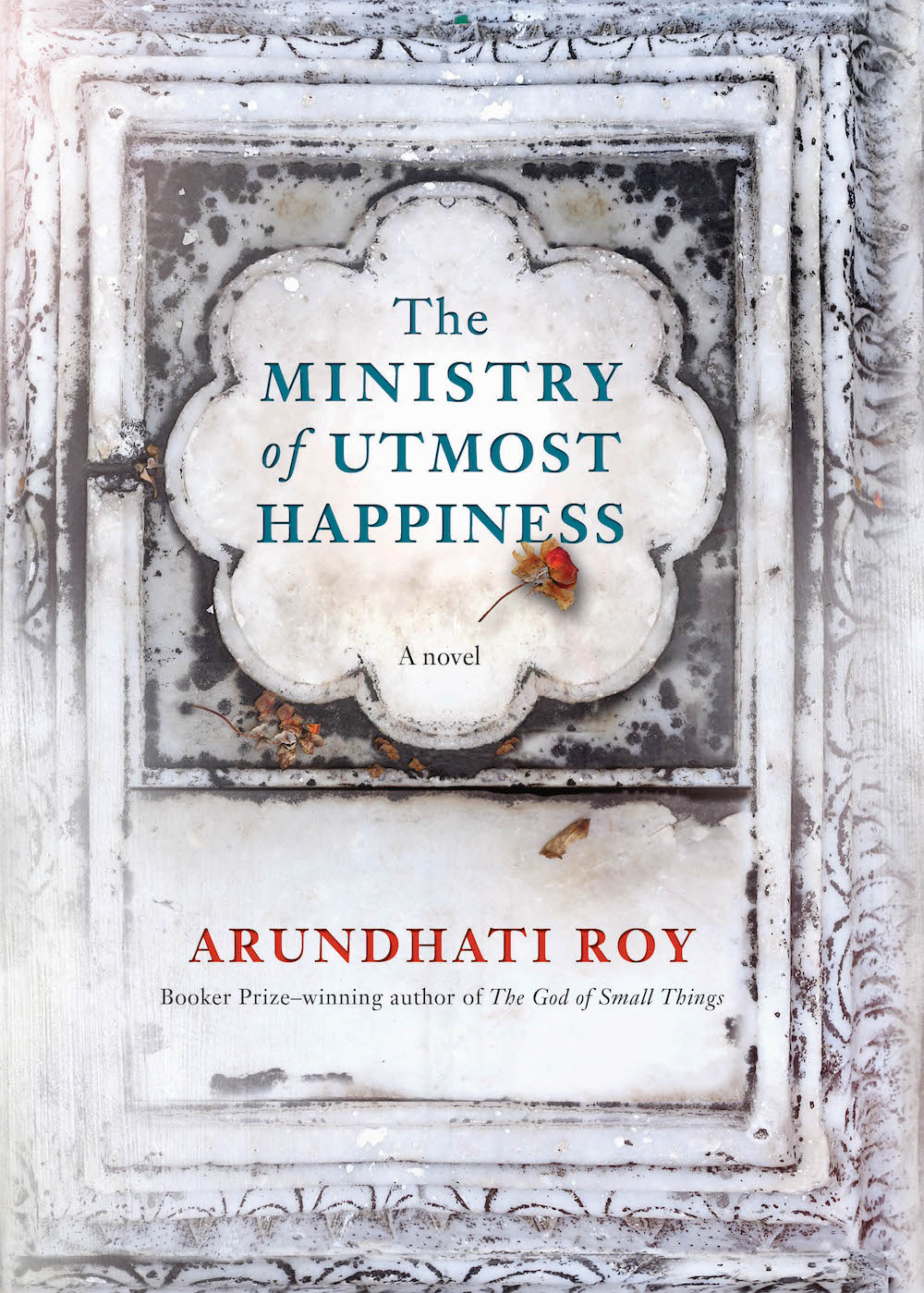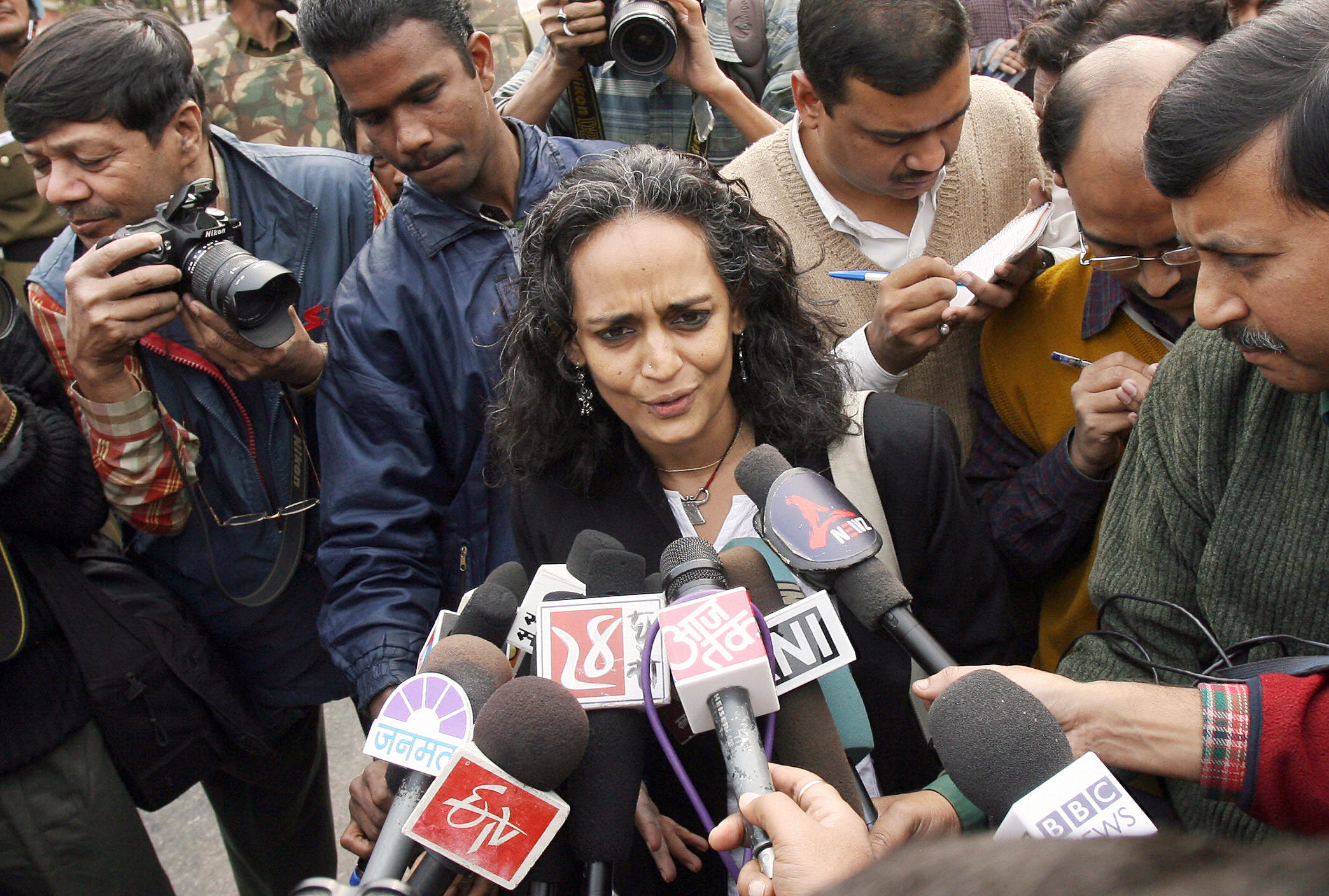Arundhati Roy believes in listening and letting patterns emerge over time. In fact, she’s made a career out of listening. Her elegiac debut novel, The God of Small Things—released in the summer of 1997—paints an intimate picture of a small town in Kerala, addressing communism and caste politics through the eyes of two fraternal twins. It earned her a Man Booker Prize for fiction, sold over eight million copies in 42 different languages worldwide, and marked a new chapter for contemporary Indian fiction.
The book’s international release positioned Roy as India’s foremost non-expatriate novelist, but her celebration was soon overshadowed by news of her country’s aggressive and showy nuclear tests the following summer, which resulted in trade sanctions, most notably by the United States and Japan. For a country approaching its first full decade of economic liberalization, the tests kindled patriotism at home and near-unanimous criticism abroad.
Roy’s protests against the tests were read as defiantly anti-national in many parts of the country. In her 1998 essay “The End of Imagination,” her dissent found clear language: “I am prepared to grovel. To humiliate myself, because, in the circumstance, silence would be indefensible.” Immediately, she stopped writing fiction and picked up a megaphone.
In the two decades since then, the 55-year-old writer has produced a small library of non-fiction that chronicles her prolific activism, demonstrating spectacular range. She has derided India’s muscular brand of Hindu nationalism, its bulldozer industrialization, and the interference of corporate forces in state politics. Roy’s subjects have changed, but her approach remains consistent. Her work is steeped in the experiences of India’s poor, whether in Delhi’s Muslim provinces or in Andhra Pradesh’s tribal communities—a biting reminder of who is left behind when a country modernizes rapidly.
Roy’s fiction remains focused on re-telling India’s modern history, this time from the perspective of those who were left out; those for whom even having a voice in public discourse is radical.
Because of her public rejection of India’s growing wave of national populism, the Delhi-based writer has emerged as a voice for India’s leftmost left—a position that has earned her a sturdy following abroad and growing hostility at home. Roy’s anti-establishment politics have agitated major sections of India’s right-wing government—the Bharatiya Janata Party—and its most energetic supporters and investors, resulting in her brief imprisonment, two charges of sedition and contempt, and several nasty opinion pieces in the Indian press. Although the trend is not likely to end soon, Roy remains characteristically uncompromising: “I’m just in the paws of this places, and this place is in the paws of me,” she said in an interview with Vogue last month.

(Photo: Sondeep Shankar/Getty Images)
While her non-fiction is the product of urgent circumstances, written under quick deadlines and rapid political shifts, her fiction takes time. When news broke that Roy was returning to novels after a 20-year hiatus, it quickly became the stuff of international headlines.
Her new book, The Ministry of Utmost Happiness, spans the breadth of India’s modern history, beginning in the years following then-Prime Minister Indira Gandhi’s unilateral declaration of emergency in 1975, which exposed, for the first time on a national scale, major cracks in India’s newly independent democratic state apparatus. These cracks, Roy would argue, have long existed—and they’re where most of her characters exist too.

The new novel’s ambitious historical arc is aware of the world outside the Indian subcontinent but rarely strays into it. With a generation of new South Asian diaspora novelists—plus one rather old one—craning their necks toward Europe and the U.S., Roy’s unshakable faith in Indian stories is a welcome contrast. The characters in her newest book exemplify this faith.
Ministry is sliced neatly into three parts: two short novella-like sections and a longer central section. Much of the novel’s action takes place in a graveyard in Delhi, where many of Roy’s main characters either live or pass through. The first two sections (short then long) illustrate the lives of the book’s two protagonists: Anjum, a transgender woman from Delhi, and Tilo, a fugitive from Kashmir’s ongoing civil conflict; the third section ropes these otherwise disconnected stories back together. Roy lobs her plotlines into the air and then shuffles to catch them.
The book opens with the birth of Aftab, a transgender—or hijra—baby born in Shahajanabad, Delhi’s walled, majority-Muslim province. Aftab’s mother’s discovery of his “small, unformed, but undoubtedly girl-part” conjures a conflict Roy often places within her main characters: how to navigate love in a world where many have been deemed unworthy of it. Hijras have historically occupied this difficult space, having only recently gained constitutional visibility in 2014. Most hijras still struggle for employment and social mobility, often resorting to begging and prostitution.

(Photo: Knopf Doubleday)
Love, from the very beginning, is scarce in Aftab’s Delhi, as he reconciles his conflicting biological and social identities. Eventually he transitions to become Anjum and moves into what Roy calls the “House of Dreams,” where a community of self-sufficient hijras resides. As the story unfolds, Anjum becomes a lens through which Roy addresses the hypocritical position Indian social norms take toward its transgendered people.
After a traumatic incident in the 2002 Gujrat riots (where the state government targeted the region’s minority Muslim population), Anjum decides to “enter another world,” leaving the House of Dreams to move into a graveyard, which she later fashions into the Jannat Guest House, a sanctuary for outcasts, including hijras, converted Muslims, and Dalits (that is, formerly “untouchable” communities excluded from the four-tier Hindu caste structure prevalent in South Asia). In a way, this is the story of Delhi too, a mashed-up paradise into which all of India’s loose objects have slid after Partition. Traversing its many doorways, Anjum’s life is constantly adjacent to the lives of others—and to other lives she could lead.
By the end of the first section of the novel, Roy’s aspirations for Ministry have become clear: “I want to write where I’m just drifting around, the way I do in Delhi” as she recently told the Guardian. “I never want to walk past anyone.” Delhi is a place where contrasting worlds co-exist, freshly developed flyovers cloak tin-roofed huts. Roy’s fiction attempts to equalize these worlds, giving a platform to voices that often get drowned out in the buzzing traffic.
“How to tell a shattered story? By slowly becoming everybody. No. By slowly becoming everything.”
This attentive empathy shows, too, in Roy’s narration, which is so energetic it sometimes overflows—like an old friend who begins talking from a distance, before they’ve even reached you. As in her activism, Roy’s fiction remains focused on re-telling India’s modern history, this time from the perspective of those who were left out; those for whom even having a voice in public discourse is radical. Roy illustrates the sentiment in one of Ministry‘s most memorable passages:
To be present in history, even as nothing more than a chuckle, was a universe away from being absent from it, from being written out of it altogether. A chuckle, after all, could become a foothold in the sheer wall of the future.
All of Roy’s characters, spanning this novel and her last, have an expansive imagination for what’s possible: If their disenfranchisement locks them in their social worlds, their sense of hope and connection can rescue them—if only momentarily. It’s with this sense that Roy leaves Anjum, cracks her knuckles, and launches into her second of two stories.
Ministry‘s next section could be a novel of its own, and perhaps it should have been. It details the life of an architecture school student named S Tilottama, or Tilo, and the three men who love her: Naga, a left-wing Indian journalist; Bilap Dasgupta, a respected officer in the Indian Intelligence Bureau; and, most important, Musa, a Kashmiri militant.
Since Anjum, the book’s world has expanded significantly. Characters appear and disappear but never crowd the page. Roy spends time with each one, either through winding introspection, epistolary prose, or one-on-one conversations. She tests her readers’ patience, piling narrative on narrative without much explanation. This tack is both frustrating and clarifying: Roy creates full people—relics of a mistold history—but they lack direction, bobbing toward and away from one another inside a loose retelling of history. Ministry is replete with characters waiting to finish telling their stories, and, after many winding interjections, they ultimately manage to do so.
From this deliberate cacophony emerges a story that drives the rest of the novel, and it’s one worth finishing: the tale of Tilo and Musa. When we meet them, their lives have become enmeshed in the violence in Kashmir, a valley lacerated into two main portions, administered by India and Pakistan (with a crumb for China too), a place where “normalcy [is] always a declaration.” The story pits the quietness of young, forbidden love against the loud rebellion of the Kashmiri uprising, sometimes causing Roy to refocus her lens—arguably too often—to fit the story of these two characters into the complex story of their world.
To understand the motivations of characters like Tilo and Musa, it’s important to understand the world that produced them. The Kashmir valley has seen pendulum-like shifts between conflict and calm, rooted in Kashmiri separatists’ demand for a plebiscite, as stipulated by a United Nations resolution in 1948.
Nevertheless, both the Indian and Pakistani governments have continued to argue for their right over the region in increasingly complex ways: through fraudulent elections, mass-conversion programs, and corrupt state governments that come to power because of low voter turnouts. If Kashmiris try and participate in any democratic process that isn’t a plebiscite, they risk the wrath of local militants; if they don’t, they risk being blinded with pellet guns from the Indian army. Many from the younger generation of protestors weren’t even around when the plebiscite was first mandated. Living a life on the run has normalized death for Musa, as it has for many of his comrades. Through the second section of the novel, he repeatedly tells Tilo about his dream of dying in combat.
Roy herself has faced the ugly dangers of picking a side. Last month, spurred by a falsely reported story, a BJP member of parliament suggested tying the writer to the front of an Indian army jeep as a human shield against protestors throwing stones. Roy—who fled India last year for a hotel room in London to finish the very novel we’re talking about—hasn’t even finished the paperwork on her most recent court charge. Such are the perils of simply imagining an alternative in modern India.

(Photo: Prakash Sing/Getty Images)
As they do in reality, these threats permeate Ministry‘s fictitious world too. Tilo and Musa are caught in the middle of Kashmir’s ideological tug-of-war, giving the book an eerie proximity to the very real violence that inspired it. Musa, who emerges as an archetype of a militant Kashmiri separatist, eventually falls in love with Tilo. In the sections they are apart, both are harassed by nightmares of the other’s death. Given the reality, both also know that the only way to deal with nightmares is “to embrace them like old friends and manage them like old enemies.” Because their relationship is never not under threat from outside forces, the brief and periodic moments between them become the uneven heartbeat of the novel:
“She had always loved that about him, the way he belonged so completely to a people whom he loved and laughed at, complained about and swore at, but never separated himself from. Maybe she loved it because she herself didn’t—couldn’t—think of anybody as ‘her people.'”
As Ministry makes its final turn, Tilo, after once again being separated from Musa, finds refuge in the Jannat Guest House with Anjum, who, as if by some magical act of narrative suspension, has been here all along. On their final night together, Musa reads a poem that Tilo intends as her future epitaph: How to tell a shattered story? By slowly becoming everybody. No. By slowly becoming everything.
These lines also capture Roy’s approach to fiction in Ministry: It is large-hearted if sometimes unfocused in its ambition to tell as full a story as possible. The characters are broken pieces, unable to reflect a coherent truth until they’re placed together. And while their coming-together isn’t always graceful, it suggests the possibility of a remarkable co-existence—lives stitched in a kind of tapestry, as Roy has called the novel.
The book forgoes a cathartic resolution in favor of a quieter ending. Anjum momentarily leaves the guest house for a night stroll with Miss Udaya Jebeen, a foundling recovered from a Delhi protest earlier in the novel. On returning, Anjum feels overwhelmingly calm, that “things would turn out all right in the end.” The same sense of hope that has carried her this far into the novel carries her out of it.
Roy has slipped us toward a quiet truth here: Anjum, and those like her, will continue to live as they do, on the outskirts, in graveyards and outhouses; Musa will return to the war and die a martyr’s death, the same way many before him have and after him will. Many of the lives in the book will continue too, in their small ways, with entire universes continuing to brush shoulders without noticing.
This feels true enough—to tell the story and expect nothing else. Roy, who has a knack for running into a dark room with outstretched hands, also has a knack for seeing what others miss, for illuminating cracks wherever they form. Ministry is a much-needed look home, an attempt to question the often-futile task of defining a national identity and whom it includes and excludes. At its most brilliant, the novel reminds us that India, while often a point of departure, can also have a literary future of its own.





